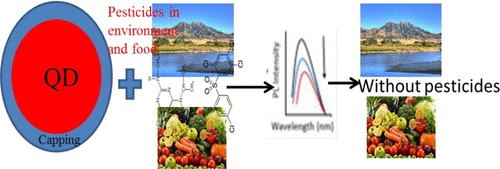当前位置:
X-MOL 学术
›
J. Agric. Food Chem.
›
论文详情
Our official English website, www.x-mol.net, welcomes your
feedback! (Note: you will need to create a separate account there.)
Nanosensing of Pesticides by Zinc Oxide Quantum Dot: An Optical and Electrochemical Approach for the Detection of Pesticides in Water
Journal of Agricultural and Food Chemistry ( IF 5.7 ) Pub Date : 2018-01-05 00:00:00 , DOI: 10.1021/acs.jafc.7b04188 Dibakar Sahoo 1 , Abhishek Mandal 2 , Tapas Mitra 1 , Kaushik Chakraborty 3 , Munmun Bardhan 4 , Anjan Kumar Dasgupta 1
Journal of Agricultural and Food Chemistry ( IF 5.7 ) Pub Date : 2018-01-05 00:00:00 , DOI: 10.1021/acs.jafc.7b04188 Dibakar Sahoo 1 , Abhishek Mandal 2 , Tapas Mitra 1 , Kaushik Chakraborty 3 , Munmun Bardhan 4 , Anjan Kumar Dasgupta 1
Affiliation

|
Present study reveals the low concentrations (∼4 ppm) of pesticide sensing vis-à-vis degradation of pesticides with the help of nontoxic zinc oxide quantum dots (QD). In our study, we have taken four different pesticides viz., aldrin, tetradifon, glyphosate, and atrazine, which are widely used in agriculture and have structural dissimilarities/diversity. By using optical sensing techniques such as steady state and time-resolved fluorescence, we have analyzed the detailed exciton dynamics of QD in the presence of different pesticides. It has been found that the pesticide containing good leaving groups (−Cl) can interact with QD promptly and has high binding affinity (∼107 M–1). The different binding signatures of QD with different pesticides enable us to differentiate between the pesticides. Time resolved fluorescence spectroscopy provides significant variance (∼150–300 ns) for different pesticides. Furthermore, a large variation (105 Ω to 7 × 104 Ω) in the resistance of QD in the presence of different pesticides was revealed by electrochemical sensing technique. Moreover, during the interaction with pesticides, QD can also act as a photocatalyst to degrade pesticides. Present investigation explored the fact that the rate of degradation is positively affected by the binding affinity, i.e., the greater the binding, the greater is the degradation. What is more, both optical and electrochemical measurements of QD, in tandem, as described in our study could be utilized as the pattern recognition sensor for detection of several pesticides.
中文翻译:

氧化锌量子点对农药的纳米感测:光学和电化学方法检测水中的农药
本研究揭示了在无毒氧化锌量子点(QD)的帮助下,相对于农药降解而言,农药检测的浓度较低(约4 ppm)。在我们的研究中,我们采用了四种不同的农药,即艾氏剂,敌敌畏,草甘膦和at去津,它们在农业中被广泛使用并具有结构上的差异/多样性。通过使用诸如稳态和时间分辨荧光之类的光学传感技术,我们分析了在不同农药存在下量子点的详细激子动力学。已经发现,含有良好离去基团(-Cl)的农药可以与QD快速相互作用,并具有很高的结合亲和力(〜10 7 M –1)。QD与不同农药的不同结合特征使我们能够区分农药。时间分辨荧光光谱法为不同农药提供了显着的变化(约150-300 ns)。此外,大的变化(10 5 Ω〜7×10 4通过电化学传感技术揭示了在不同农药存在下QD的电阻(Ω)。此外,在与农药相互作用期间,量子点还可以充当光催化剂来降解农药。当前的研究探索了降解速率受结合亲和力正面影响的事实,即结合越大,降解越大。此外,如我们的研究所述,QD的光学和电化学测量可以串联作为模式识别传感器,用于检测多种农药。
更新日期:2018-01-05
中文翻译:

氧化锌量子点对农药的纳米感测:光学和电化学方法检测水中的农药
本研究揭示了在无毒氧化锌量子点(QD)的帮助下,相对于农药降解而言,农药检测的浓度较低(约4 ppm)。在我们的研究中,我们采用了四种不同的农药,即艾氏剂,敌敌畏,草甘膦和at去津,它们在农业中被广泛使用并具有结构上的差异/多样性。通过使用诸如稳态和时间分辨荧光之类的光学传感技术,我们分析了在不同农药存在下量子点的详细激子动力学。已经发现,含有良好离去基团(-Cl)的农药可以与QD快速相互作用,并具有很高的结合亲和力(〜10 7 M –1)。QD与不同农药的不同结合特征使我们能够区分农药。时间分辨荧光光谱法为不同农药提供了显着的变化(约150-300 ns)。此外,大的变化(10 5 Ω〜7×10 4通过电化学传感技术揭示了在不同农药存在下QD的电阻(Ω)。此外,在与农药相互作用期间,量子点还可以充当光催化剂来降解农药。当前的研究探索了降解速率受结合亲和力正面影响的事实,即结合越大,降解越大。此外,如我们的研究所述,QD的光学和电化学测量可以串联作为模式识别传感器,用于检测多种农药。











































 京公网安备 11010802027423号
京公网安备 11010802027423号